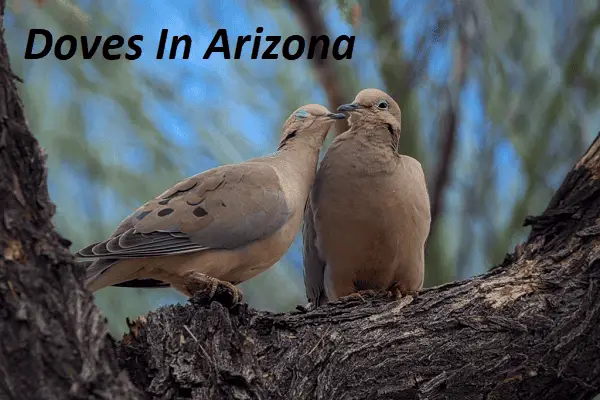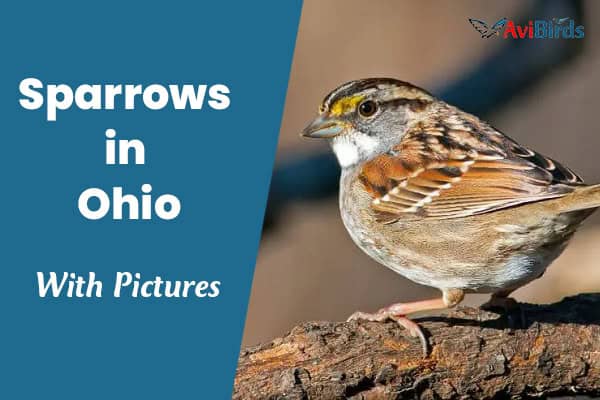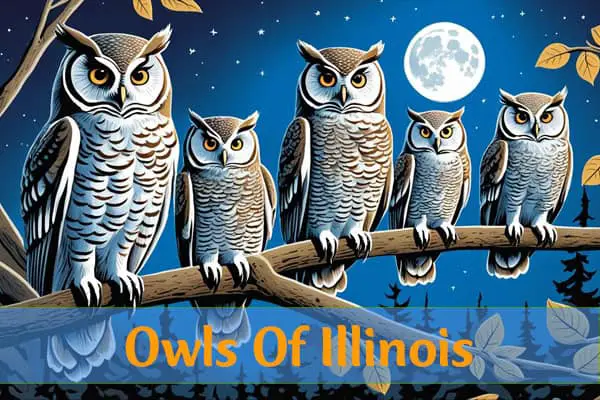5 Doves In Arizona (With Pictures)
“Doves in Arizona” may not spring to mind first, but they’re a hidden gem in the desert. I’ve researched these elegant creatures, and they’re as diverse as they are captivating. From their distinct coos to their varied habitats, they add a touch of grace to the arid landscape.
Let’s explore their world together, discovering the charm of each species. Ready for an enchanting dive into the lives of Arizona’s doves? They promise a delicate beauty that’s simply unforgettable.
Here, We’ll learn About 5 Different Types of Doves That Live in Arizona!
1. Mourning Dove (Zenaida Macroura)

Mourning Dove 9-13 inches 17-19 inches
The Mourning Dove, scientifically known as Zenaida Macroura, is one of the most prevalent species of doves in Arizona. Also, these birds are mostly found in North America and are particularly common in the habitats of Arizona.
Characteristics
The Mourning Dove is a medium-sized bird, measuring 9-13 inches in length with a wingspan of 17-19 inches. It has a slender body and a long, pointed tail. The plumage of the Mourning Dove is mainly gray-brown, with a lighter underbelly. Its head is delicate, featuring a small black bill, dark eyes, and a distinctive blue orbital ring. On the wings, there are black spots and white patches that can be seen during flight.
Behavior
Mourning Doves are known for their gentle and peaceful nature. They are often found in small flocks, foraging on the ground for seeds, grains, and fruits. Their soft cooing sound, resembling mournful whistling, is common in Arizona’s countryside. These birds are highly adaptable and able to thrive in urban environments as well as rural areas.
Habitat and Distribution
Mourning Doves have a wide habitat range, from forests and open woodlands to deserts and suburban areas. In Arizona, they can be commonly spotted in grasslands, agricultural fields, urban parks, and areas abundant with saguaro cacti. These doves are migratory, with some populations residing in Arizona year-round, while others migrate to the state during the breeding season.
“The beauty of the Mourning Dove lies not only in its gentle appearance but also in its soothing cooing call, which can bring a sense of calm to any natural setting.”
Overall, the Mourning Dove is a beloved and familiar sight in Arizona. Its soft colors and serene presence make it a favorite among birdwatchers and nature enthusiasts alike.
2. Common Ground-Dove (Columbina Passerina)
The Common Ground-Dove, scientifically known as Columbina Passerina, is a beautiful species of dove that can be frequently observed in the desert areas of Arizona. With their small size and distinctive features, these doves have adapted remarkably well to the arid environment of the Sonoran Desert.

One of the best characteristics of the Common Ground-Dove is its unique call, which is a soft, rhythmic cooing sound that often goes unnoticed amongst the bustling sounds of the desert. Moreover, This gentle call is an essential part of their communication repertoire and helps them establish their territory and attract mates. It’s truly a mesmerizing experience to hear their melodious call echoing through the desert.
As their name suggests, Common Ground-Doves prefer to dwell on the ground rather than in trees or perches like some other dove species. This ground-dwelling habit allows them to forage for seeds, grains, and small insects on the sandy desert floor more efficiently. Their petite size and agile movements make them experts at navigating through the intricate desert vegetation.
When it comes to their habitat preferences, Common Ground-Doves are most commonly found in open areas with sparse vegetation, such as grasslands, agricultural fields, and desert scrub regions. Moreover, They are also known to frequent parks, golf courses, and residential areas where there are ample food sources and suitable areas for nesting.
These doves often form small flocks, and their presence adds charm and character to the Arizona desert landscape. Sharing space with other bird species, including other doves and quail, they coexist harmoniously, each finding their niche within the ecosystem.
Precision Landing: Rigorous Flying Skills
The Common Ground-Dove’s impressive flying skills are not to be underestimated. Despite their small size, they are skilled and agile fliers, capable of swiftly maneuvering through obstacles in pursuit of their daily activities. Their intricate flight patterns include quick take-offs and landings, allowing them to navigate the desert terrain with remarkable precision.
Common Ground-Dove Characteristics Habitat Preferences Distinctive Traits
Small size Open areas with sparse vegetation Distinctive call
Ground-dwelling Grasslands, agricultural fields, desert scrub regions Skilled fliers
Cohabit with other bird species Parks, golf courses, residential areas Resilient in harsh environments
With their unique characteristics, ground-dwelling habits, and adaptive behaviors, the Common Ground-Doves are an integral part of Arizona’s avian diversity. They add beauty and tranquility to the desert landscape, captivating bird enthusiasts and nature lovers alike.
3. White-Winged Dove (Zenaida Asiatica)
The White-Winged Dove, scientifically known as Zenaida Asiatica, is another common dove species found in Arizona. These doves are known for their distinctive white wing patches and beautiful cooing melodies. In addition to their enchanting appearance and songs, White-Winged Doves also serve a vital ecological role in Arizona’s wildlife.
Moreover, These doves are highly adaptable and can be found in different of habitats, including desert areas, urban environments, and agricultural lands. They’re plentiful in the Sonoran Desert, thriving in its arid, cactus-filled landscape.
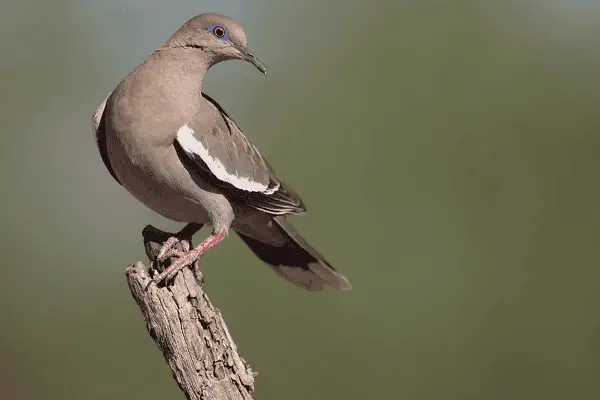
White-Winged Doves play a crucial role in the pollination of desert plants, as they feed primarily on fruits and nectar. Their foraging behavior makes them efficient pollinators, helping to ensure the survival and reproduction of various plant species in the region.
The breeding season for White-Winged Doves in Arizona typically occurs from April to August. During this time, males engage in elaborate courtship displays to attract female mates. Once paired, they build flimsy nest platforms using twigs and vegetation, usually in shrubs or trees.
Observing White-Winged Doves in their natural habitat can provide a delightful experience for birdwatchers and nature enthusiasts. Their unique appearance, distinct vocalizations, and graceful flight make them a popular subject for photographers and bird lovers alike.
To summarize, the White-Winged Dove, Zenaida Asiatica, is a notable species in Arizona’s rich avian diversity. With their beautiful plumage, important ecological role, and wide distribution, these doves contribute significantly to the state’s wildlife, making them a fascinating subject for birdwatching and ecological studies.
4. Inca Dove (Columbina Inca)
The Inca Dove, also known as Columbina Inca, is a unique species of dove found in the southwestern United States, including Arizona, often compared with the Band-tailed Pigeon due to their habitat preferences. These doves have beautiful rufous-colored wings and are often seen in urban areas, including dense brushy habitats and riparian areas.

Unlike some other dove species, Inca Doves have a distinctive scaled pattern on their wings, adding to their charm. Their small size and delicate appearance make them a favorite among birdwatchers and nature enthusiasts.
Behavior:
Inca Doves are highly social birds and can often be seen in large flocks. They are known for their characteristic fluttering flights, which are a part of their courtship displays. These doves have a soft, mournful cooing call, similar to the Mourning Dove, but with a slightly higher pitch.
Habitat and Location:
Inca Doves are adaptable and can thrive in a variety of habitats. However, they are commonly found in open areas such as desert scrub, residential neighborhoods, parks, and agricultural lands. They are often found near a reliable source of water, as doves and pigeons require regular access to water for drinking and bathing.
When searching for Inca Doves in Arizona, keep an eye out for areas with dense brushy vegetation, low shrubs, and trees. These birds are known to build their nests in these areas, providing them with both shelter and a suitable breeding environment.
Identification:
Identifying Inca Doves can be relatively easy due to their unique appearance. In addition to their rufous wings, they have a grayish body and a thin black bill. Their long, tapered tail with white outer feathers is another distinctive feature that sets them apart from other dove species.
- Inca Dove (Columbina Inca) Identification
- Size Approximately 6-7 inches in length
- Coloration Rufous wings, grayish body, white outer tail feathers
- Call Soft, mournful cooing sound
- Habitat Urban areas, dense brushy habitats, riparian areas
Conservation Status:
The Inca Dove is not currently listed as a threatened or endangered species. However, like many other bird species, they face threats such as habitat loss, urbanization, and predation. Conservation efforts, including preserving their natural habitats and raising awareness about the importance of their role in the ecosystem, can help ensure the continued well-being of these beautiful birds.
Whether you encounter an Inca Dove during a peaceful walk in your neighborhood or while exploring the natural beauty of Arizona, take a moment to appreciate the subtle grace and unique charm of this extraordinary species.
5. Eurasian Collared-Dove (Streptopelia Decaocto)
The Eurasian Collared-Dove, scientifically known as Streptopelia Decaocto, is a non-native species that has rapidly spread across North America, including Arizona. Originally introduced to the Bahamas in the 1970s, these doves have since established themselves in Arizona and other states.
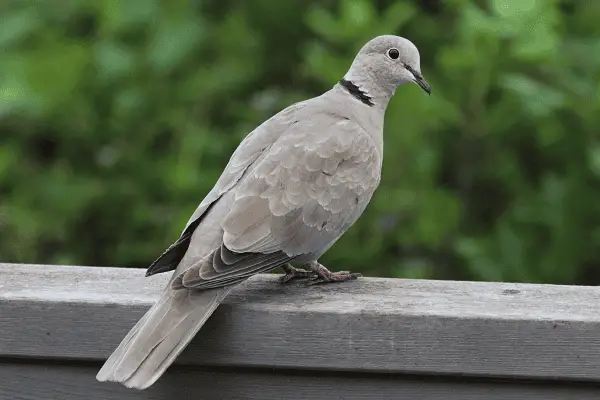
This dove species is recognized for its distinctive appearance and behavior. The Eurasian Collared-Dove has a pale gray body complemented by a black neckband or “collar,” which differentiates it from other dove species found in Arizona.
With an average length of approximately 32 centimeters, these doves are slightly larger than the native Mourning Dove and the commonly found Rock Pigeon. They have a wingspan of about 47 centimeters, allowing them to gracefully glide through the skies.
Habitat and Behavior
The Eurasian Collared-Dove is highly adaptable and can be found in a variety of habitats, including urban areas, farmlands, suburban neighborhoods, and open woodlands. They are known to thrive in regions with mild winters and abundant food sources.
These doves are primarily granivorous, meaning they mainly feed on seeds. They are often spotted perched on telephone wires, rooftops, or trees, where they scan the surroundings for food. Their diet consists of grains, seeds, fruits, and occasionally insects.
These doves have a distinctive call, which has been described as a soft, melodic “coo-COO-coo.” Their vocalizations are most active during the morning and evening hours.
Check Our Previous Articles:
Impact on Ecosystems
The rapid expansion of the Eurasian Collared-Dove population has raised concerns about its potential impact on native dove species and ecosystems. This non-native species compete with native birds for resources, including food and nesting locations.
Research suggests that the Eurasian Collared-Doves may displace native dove species and cause declines in their populations. Their adaptability and ability to reproduce year-round give them a competitive advantage over other dove species.
“The Eurasian Collared-Dove’s spread across North America has been remarkable, and their impacts on native bird populations are still being studied. Understanding their behavior, habitat preferences, and ecological interactions is crucial for effective conservation efforts.” – Dr. Sarah Johnson, Avian Ecologist.
Final Thoughts:
Arizona hosts diverse dove and pigeon species, each with unique traits and habitat preferences. The state’s biodiversity allows for ample bird-watching opportunities.
From the Mourning Dove, recognized for its mournful call and wide range, to the urban-dwelling Inca Dove with its distinctive rufous wings, Arizona provides diverse habitats for doves. Whether you’re a bird enthusiast or a hunter, Arizona’s landscapes, spanning deserts, riparian zones, and urban areas, offer chances to explore.
For bird lovers, observing Arizona’s doves offers insight into their behaviors and adaptability. Nature reserves and bird-watching spots provide glimpses of these captivating birds.
For hunters, Arizona’s abundant dove populations make it a favored destination. With various hunting seasons and regulations, the state ensures sustainable hunting practices while preserving wildlife.
Frequently Asked Questions:
Q1. What kind of doves are in Arizona?
Mourning doves are commonly found in Arizona.
Q2. Does Arizona have a dove season
Yes, Arizona has a designated dove hunting season.
Q3. Do doves in Arizona migrate?
Some doves in Arizona migrate, particularly the mourning doves, which migrate seasonally.
Q4. Do pigeons live in AZ?
Yes, pigeons can be found living in Arizona, particularly in urban areas.

